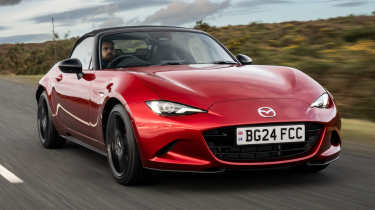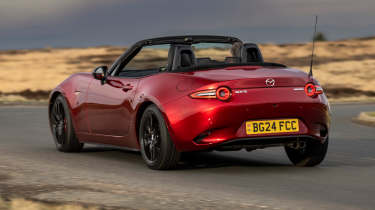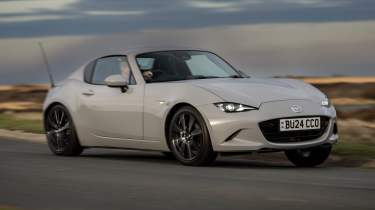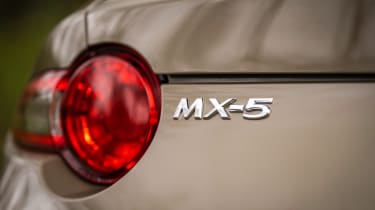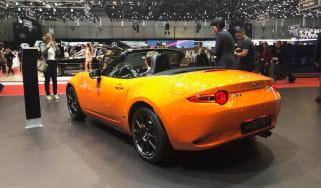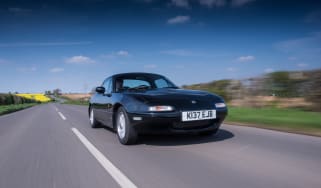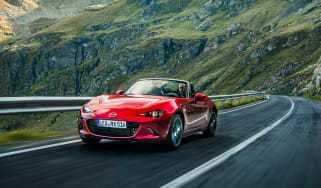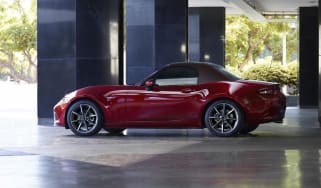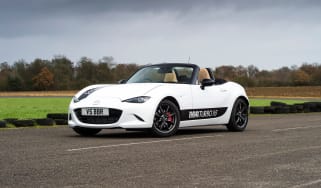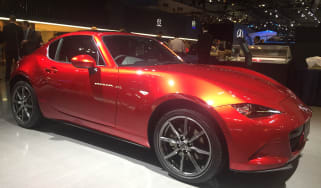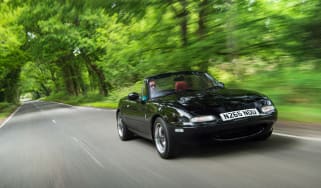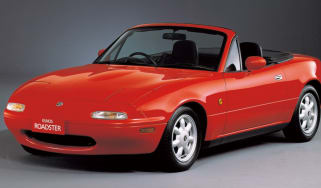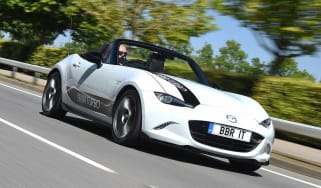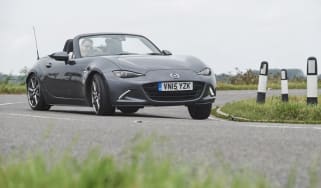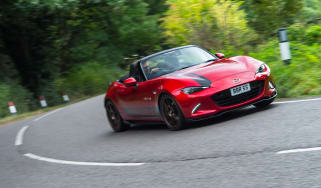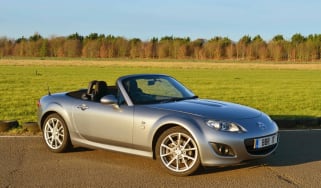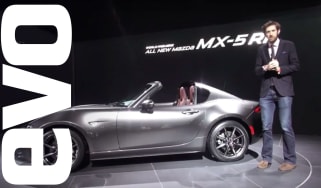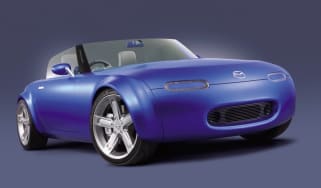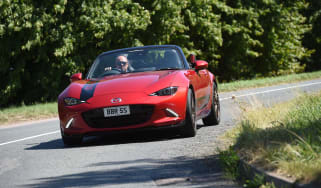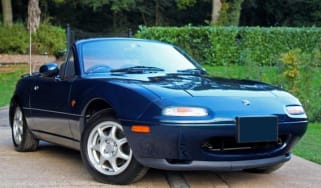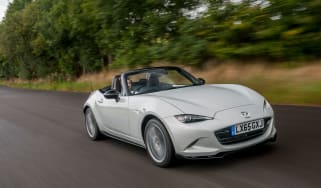Mazda MX-5 review – Japan’s evergreen roadster refreshed
The Mazda MX-5 is better than ever and is a breath of fresh air in the 2025 performance car landscape
The Mazda MX-5 is one of the best-selling sports cars of all time, evolving incrementally in its 35 years but rarely at the expense of its core ethos of simplicity and light weight. The MX-5 is long-lived, too, with only four generations spanning its tenure. The fourth-generation ‘ND’ is approaching its tenth year on sale but a 2024 facelift has given it a refreshed look, an updated cabin, revised mechanicals and electronics, and crucially, negligible weight gain.
Could you dismiss it as old-fashioned in 2024? Quite possibly, but that’s looking at it the wrong way. Rather, the MX-5 sticking so resolutely to what has defined it for over three and a half decades, and to the back-to-basics two-seat roadster formula Mazda so studiously emulated, is entirely refreshing in a marketplace of EVs, SUVs and the brute force over deft execution attitude to performance cars that is so pervasive at the moment.
In the 35 years since it launched, the MX-5 has gone up in kerb weight by less than 100kg. By contrast, a 1989 BMW M5 is some 700kg lighter than its modern day equivalent. The MX-5, then, remains a shining beacon of affordable fun; a standard bearer for simplicity and a less-is-more approach, as the cars around it get faster, heavier and often more disconnected.
More reviews
Group tests
Review
Reviews
- Performance Link Mazda MX-5 R300 review – an MX-5 with Honda VTEC power
- Mazda MX-5 RF 2025 review – evo Car of the Year 2024’s people’s champion
- BBR Supercharged Mazda MX-5 (NC) 2022 review – frenzied, affordable fun
- Mazda MX-5 R Sport 2020 review – floats like a butterfly, but stings like one too
- BBR Super 225 Mazda MX-5 review
> Toyota GT86 v GR86: how Toyota perfected the affordable sports car
That said, it can take a little time to appreciate an MX-5. It's rare that a modern performance-orientated car rolls so much in corners, which can feel like a lack of focus in a market where even entry-level hot hatches are razor-sharp and blisteringly quick. That, of course, is deliberate on Mazda's part – the MX-5 is designed for interaction, connection and driving pleasure, rather than outright lap times.
Those body movements make you feel like you're cornering hard, even when you're not. Drive flat-out and you'll be left wanting more control, albeit less so in this latest iteration. Drive enthusiastically down a familiar stretch of road however and you feel completely involved in the experience. The MX-5's willing naturally-aspirated engines are central to this, with the 2-litre engine having received a thorough overhaul since the ND's launch to add power – and more importantly revs – to the package. The raspy exhaust and responses unsullied by turbocharging, plus a fantastically snappy gear shift and a new more progressive limited-slip differential, all combine to make even a drive to the shops an experience worth savouring.
And you can drop the roof on a sunny day, which adds an extra dimension to a car that even after 35 years, is still largely without a direct rival. For those who insist on a tin-top there is also the MX-5 RF with its electric folding targa-style roof, which adds the looks of a coupe and some semi-exotic buttresses but retains many of the roadster’s attributes and quirks.
Mazda MX-5: in detail
- > Performance and 0-60mph time - Low mass and rear-drive traction help the modest power output translate into a 6.5sec 0-62mph dash for the 2-litre roadster and 6.8 seconds for the heavier RF.
- > Engine and gearbox - 1.5- and 2-litre engine options, both four cylinder and naturally aspirated, provide the power, while both come standard with one of the best six-speed manuals on the market.
- > Ride and handling - Some body roll and a bit of body shake, too. Can feel alien or refreshing, depending on the quality of modern performance car you’ve just stepped into it from.
- > MPG and running costs - Small engines and low weight mean decent economy – up to 47mpg. Even 2-litre models do over 40mpg at a steady cruise.
- > Interior and tech - Taller drivers may find the cabin cramped, but for shorter drivers it’ll fit like a glove. Crisp new 8.8-inch infotainment screen for 2024
- > Design - Classic sports car proportions, modern Japanese design. Perfect. Fussy DRLs binned, with stylish integrated items for 2024.
Mazda MX-5 ND history
Launched in 2015 the ND generation of MX-5 was available with a brace of Skyactiv engines in 1.5- and 2-litre capacities. While the 2-litre version was undoubtedly the quicker of the two, the 1.5 was the more engaging drive due to the free-revving nature of its engine. In the latter part of 2018, heavily revised engines came on stream, and the 2-litre now developed more power and was much sweeter than its earlier incarnation. The larger-engined models also receive a limited-slip differential and Sport models are the most driver focused thanks to Bilstein dampers, although the raspier and more compliant 1.5-litre version plays to the car's natural strengths well.
Mazda MX-5 (Mk2, NB, 1998-2005; Mk3, NC, 2005-2014)
The second generation of MX-5, the NB, built on the successful recipe of the original NA model, and while it had grown and added weight it was still just as much fun as its predecessor. There was a choice of 1.6- or 1.8-litre engines, and the latter did a good job of hiding the MX-5’s additional bulk. The pop-up headlights had been dropped, but the MX-5 retained excellent proportions and was surprisingly practical for a small roadster. The gearbox – either a five-speed or optional six-speed manual – retained its delightful change quality, and the handling was involving and dynamic.
The Mk3 MX-5, the NC, wasn’t quite as resolved as the cars that came before it thanks to its additional weight and a change of suspension that didn’t bring out the best from the car, making the handling a little too snappy at times. Engines were either a 1.8- or 2-litre, with the latter giving decent performance, but the adoption of electric power steering robbed the MX-5 of its steering feel and feedback. A facelift in 2009 did improve matters, though, with suspension tweaks improving the car’s balance and feedback.
NA Mazda MX-5 – the original
The original, and some would say the best, made its motor show debut in 1989 before going on sale in the UK in 1990. Powered by a 1.6-litre four-cylinder mated to a perfectly weighted five-speed manual gearbox, it was a driver’s delight. It wasn’t quick – 0-62mph took a smidgen over nine seconds and it ran out of puff at 114mph – but it was wonderfully balanced and pliant with deft handling, and couldn’t help but put a smile on your face. It was also accessible, as all MX-5s have proven to be, especially alongside its big brother at the time, the more exotic and expensive Mazda RX-7.
Prices, specs and rivals
The 2-litre MX-5 received significant engine revisions in 2018, and it was further upgraded this year with a new asymmetric limited-slip diff as part of a model-wide facelift. Costing from £28,015 is the MX-5 Prime-Line, sitting at the bottom of the range with 16-inch wheels, cloth seats and the 130bhp 1.5-litre four-cylinder – despite its basic trim level, Apple CarPlay and Android Auto are standard via the new 8.8-inch multimedia touchscreen, as are a pair of handy driver's headrest speakers for hands-free calls.
Step up to the Exclusive-line trim for £30,015 and the MX-5 keeps its 1.5-litre unit, but gains an uprated nine-speaker Bose sound system, leather seats, silver 16-inch wheels and more driver assistance systems with a new Track Mode for the Dynamic Stability control. The 2-litre models cost from £32,430, also specified in Exclusive-Line trim.
At the top of the MX-5 range is the £34,835 2-litre Homura version, featuring stainless steel scuff plates, leather and alcantara Recaro sports seats, forged 17-inch BBS wheels and uprated front Brembo brake calipers, as first seen on the 30th anniversary model. A sports suspension kit with Bilstein dampers is also included.
The folding hard-top RFs jump in price by around £2k spec-for-spec, starting from £29,915 for a 1.5-litre Prime-Line and rising to £37,035 for the top-spec Homura.
Used Mazda MX-5 (Mk4, ND, 2015 to date) buyer’s guide
If you’re looking for a small, affordable sporting soft-top your choices are pretty restricted these days, but the MX-5 ticks all of these boxes and makes a great used purchase. It’s reliable and cheap to run yet can be hugely entertaining, too. Despite having been around since 2015 the shape still looks fresh and there are plenty of used examples to choose from – this is one of the world’s most popular sports cars, after all. If you’re after a no frills model then the 1.5-litre models make an excellent case for themselves, but for a little bit more performance a post-September 2018 2-litre would be the one to go for. Special-edition models – the 30th Anniversary is a favourite – are particularly desirable and hold their value very well.
Prices range from under £10,000 for early 1.5s with a few miles to c/£15k for a nice later 2-litre car with the diff. Of course, the newer and higher spec you get, the more you before, before you end up looking at the the £25,000+ you’ll be paying for a brand new car, or more specifically, £37k for top-spec MX-5 RF Homura that came joint second on evo Car of the Year 2024.
Range, specifications and options
Both the MX-5 roadster and the RF are available with either the 1.5- or 2-litre engines, and all models come paired with a six-speed manual transmission; a six-speed paddleshift auto is also available on the RF. The 1.5-litre engine was the sweeter of the two prior to an update in 2018 which saw significant revisions to the 2-litre unit, and it’s these later 2.0i cars that perhaps offer the best both in terms of performance and driveability.
Before the current Prime, Exclusive and Homura grades, there were quite a number of trim levels to choose from – SE (1.5 only), SE-L, SE-L Nav, Sport and Sport Nav. The entry-level SE has cloth trim and basic infotainment, while SE-L adds climate control, DAB and a colour touchscreen. The addition of Nav to the model name signifies the inclusion of a navigation system, while Sport models feature a limited-slip differential and Bilstein dampers. If you like the idea of some modern safety-related equipment then a post-September 2018 model is the one to go for. Three new trim levels were added at this time – GT Sport Nav, Sport Tech and GT Sport Tech. Most of the higher-end models have lane departure warning, smart city brake and various other driver aids. As above, the latest MX-5 range has been rationalised with a three-grade lineup.
Problems, checks and recalls
Mazda has a pretty good reputation for reliability and this applies to the MX-5, with no significant problems to report with regard to engines and transmissions. The MX-5 is a lightweight compared to most modern cars so tends to be fairly gentle on its tyres, brakes and suspension, but with the oldest examples we’re getting to the point where age-related deterioration might be an issue. Shock absorbers can start to weep, suspension bushes can perish and brakes can rust, while calipers can stick, especially on lower-mileage cars that don’t receive much use.
Check the hood carefully as there is a known problem, particularly with 2015 and 2016 cars, where the inner lining can become detached – this looks unsightly and can obscure the view through the rear window. There was a service information bulletin from Mazda for the official fix for the problem.
There have been a couple of recalls on this generation of MX-5 – an undershield metal bracket may come adrift, automatic models may experience a fault with unexpected downshifts, a fuel pump impeller can deform and there’s a potential fault with the vehicle’s charging system as well. These refer to cars built between 2015 and 2018, but those built from 2019 onwards are free of any safety-related recalls.
